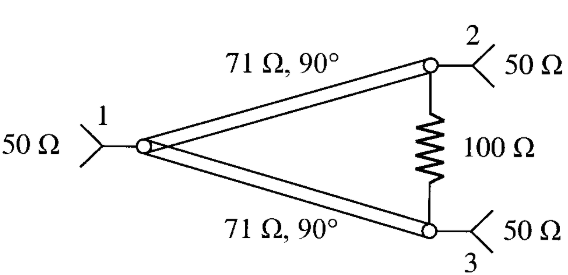Wilkinson Power Divider#
In this notebook we create a Wilkinson power divider, which splits an input signal into two equals phase output signals. Theoretical results about this circuit are exposed in reference [1]. Here we will reproduce the ideal circuit illustrated below and discussed in reference [2]. In this example, the circuit is designed to operate at 1 GHz.

[1] P. Hallbjörner, Microw. Opt. Technol. Lett. 38, 99 (2003).
[2] Microwaves 101: “Wilkinson Power Splitters”
The circuit setup can be checked by visualizing the circuit graph (this requires the python package networkx to be available).
Let’s look to the scattering parameters of the circuit:
Currents and Voltages#
Is is possible to calculate currents and voltages at the Circuit’s internals ports. However, if you try with this specific example, one obtains:
This situation is “normal”, in the sense that the voltages and currents calculation methods does not support the case of more than 2 ports are connected together, which is the case in this example, as we have defined the connection list:
connections = [
[(port1, 0), (branch1, 0), (branch2, 0)],
[(port2, 0), (branch1, 1), (resistor, 0)],
[(port3, 0), (branch2, 1), (resistor, 1)]
]
However, note that the voltages and currents calculations at external ports works:
But there is hope! It is possible to calculate the internal voltages and currents of the circuit using intermediate splitting Networks. In our case, one needs three “T” Networks and to make only pair of connections:
The resulting graph is a bit more stuffed:
But the results are the same:
And this time one can calculate internal voltages and currents:
You will find more details on voltages and currents calculation on the dedicated example.



